Huidong Liu
Temporal-Consistent Video Restoration with Pre-trained Diffusion Models
Mar 19, 2025Abstract:Video restoration (VR) aims to recover high-quality videos from degraded ones. Although recent zero-shot VR methods using pre-trained diffusion models (DMs) show good promise, they suffer from approximation errors during reverse diffusion and insufficient temporal consistency. Moreover, dealing with 3D video data, VR is inherently computationally intensive. In this paper, we advocate viewing the reverse process in DMs as a function and present a novel Maximum a Posterior (MAP) framework that directly parameterizes video frames in the seed space of DMs, eliminating approximation errors. We also introduce strategies to promote bilevel temporal consistency: semantic consistency by leveraging clustering structures in the seed space, and pixel-level consistency by progressive warping with optical flow refinements. Extensive experiments on multiple virtual reality tasks demonstrate superior visual quality and temporal consistency achieved by our method compared to the state-of-the-art.
Hierarchical Conditional Semi-Paired Image-to-Image Translation For Multi-Task Image Defect Correction On Shopping Websites
Sep 12, 2023Abstract:On shopping websites, product images of low quality negatively affect customer experience. Although there are plenty of work in detecting images with different defects, few efforts have been dedicated to correct those defects at scale. A major challenge is that there are thousands of product types and each has specific defects, therefore building defect specific models is unscalable. In this paper, we propose a unified Image-to-Image (I2I) translation model to correct multiple defects across different product types. Our model leverages an attention mechanism to hierarchically incorporate high-level defect groups and specific defect types to guide the network to focus on defect-related image regions. Evaluated on eight public datasets, our model reduces the Frechet Inception Distance (FID) by 24.6% in average compared with MoNCE, the state-of-the-art I2I method. Unlike public data, another practical challenge on shopping websites is that some paired images are of low quality. Therefore we design our model to be semi-paired by combining the L1 loss of paired data with the cycle loss of unpaired data. Tested on a shopping website dataset to correct three image defects, our model reduces (FID) by 63.2% in average compared with WS-I2I, the state-of-the art semi-paired I2I method.
Token Sparsification for Faster Medical Image Segmentation
Mar 11, 2023



Abstract:Can we use sparse tokens for dense prediction, e.g., segmentation? Although token sparsification has been applied to Vision Transformers (ViT) to accelerate classification, it is still unknown how to perform segmentation from sparse tokens. To this end, we reformulate segmentation as a sparse encoding -> token completion -> dense decoding (SCD) pipeline. We first empirically show that naively applying existing approaches from classification token pruning and masked image modeling (MIM) leads to failure and inefficient training caused by inappropriate sampling algorithms and the low quality of the restored dense features. In this paper, we propose Soft-topK Token Pruning (STP) and Multi-layer Token Assembly (MTA) to address these problems. In sparse encoding, STP predicts token importance scores with a lightweight sub-network and samples the topK tokens. The intractable topK gradients are approximated through a continuous perturbed score distribution. In token completion, MTA restores a full token sequence by assembling both sparse output tokens and pruned multi-layer intermediate ones. The last dense decoding stage is compatible with existing segmentation decoders, e.g., UNETR. Experiments show SCD pipelines equipped with STP and MTA are much faster than baselines without token pruning in both training (up to 120% higher throughput and inference up to 60.6% higher throughput) while maintaining segmentation quality.
Self Pre-training with Masked Autoencoders for Medical Image Analysis
Mar 10, 2022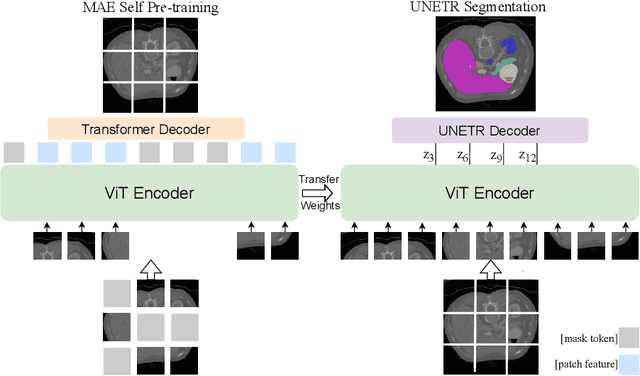
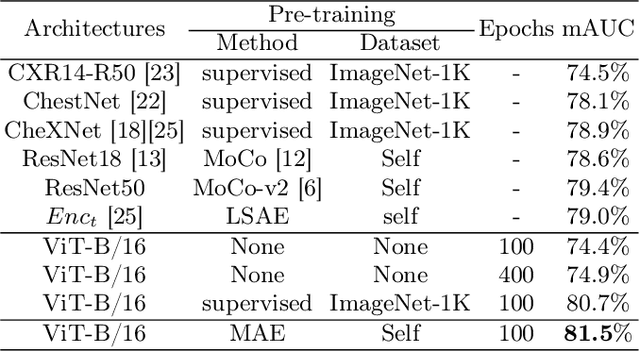
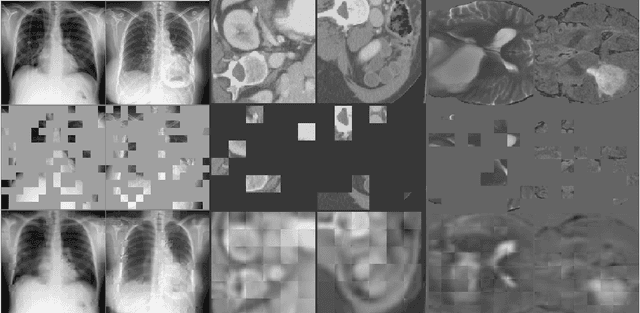

Abstract:Masked Autoencoder (MAE) has recently been shown to be effective in pre-training Vision Transformers (ViT) for natural image analysis. By performing the pretext task of reconstructing the original image from only partial observations, the encoder, which is a ViT, is encouraged to aggregate contextual information to infer content in masked image regions. We believe that this context aggregation ability is also essential to the medical image domain where each anatomical structure is functionally and mechanically connected to other structures and regions. However, there is no ImageNet-scale medical image dataset for pre-training. Thus, in this paper, we investigate a self pre-training paradigm with MAE for medical images, i.e., models are pre-trained on the same target dataset. To validate the MAE self pre-training, we consider three diverse medical image tasks including chest X-ray disease classification, CT abdomen multi-organ segmentation and MRI brain tumor segmentation. It turns out MAE self pre-training benefits all the tasks markedly. Specifically, the mAUC on lung disease classification is increased by 9.4%. The average DSC on brain tumor segmentation is improved from 77.4% to 78.9%. Most interestingly, on the small-scale multi-organ segmentation dataset (N=30), the average DSC improves from 78.8% to 83.5% and the HD95 is reduced by 60%, indicating its effectiveness in limited data scenarios. The segmentation and classification results reveal the promising potential of MAE self pre-training for medical image analysis.
Lung Swapping Autoencoder: Learning a Disentangled Structure-texture Representation of Chest Radiographs
Jan 18, 2022


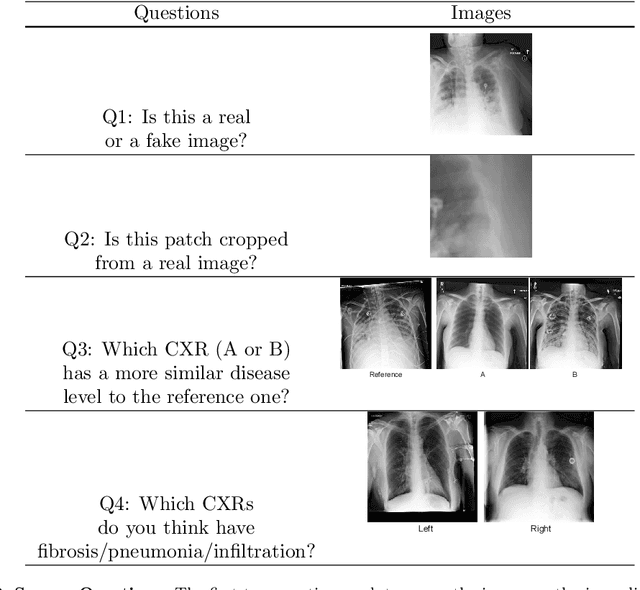
Abstract:Well-labeled datasets of chest radiographs (CXRs) are difficult to acquire due to the high cost of annotation. Thus, it is desirable to learn a robust and transferable representation in an unsupervised manner to benefit tasks that lack labeled data. Unlike natural images, medical images have their own domain prior; e.g., we observe that many pulmonary diseases, such as the COVID-19, manifest as changes in the lung tissue texture rather than the anatomical structure. Therefore, we hypothesize that studying only the texture without the influence of structure variations would be advantageous for downstream prognostic and predictive modeling tasks. In this paper, we propose a generative framework, the Lung Swapping Autoencoder (LSAE), that learns factorized representations of a CXR to disentangle the texture factor from the structure factor. Specifically, by adversarial training, the LSAE is optimized to generate a hybrid image that preserves the lung shape in one image but inherits the lung texture of another. To demonstrate the effectiveness of the disentangled texture representation, we evaluate the texture encoder $Enc^t$ in LSAE on ChestX-ray14 (N=112,120), and our own multi-institutional COVID-19 outcome prediction dataset, COVOC (N=340 (Subset-1) + 53 (Subset-2)). On both datasets, we reach or surpass the state-of-the-art by finetuning $Enc^t$ in LSAE that is 77% smaller than a baseline Inception v3. Additionally, in semi-and-self supervised settings with a similar model budget, $Enc^t$ in LSAE is also competitive with the state-of-the-art MoCo. By "re-mixing" the texture and shape factors, we generate meaningful hybrid images that can augment the training set. This data augmentation method can further improve COVOC prediction performance. The improvement is consistent even when we directly evaluate the Subset-1 trained model on Subset-2 without any fine-tuning.
CMA-CLIP: Cross-Modality Attention CLIP for Image-Text Classification
Dec 09, 2021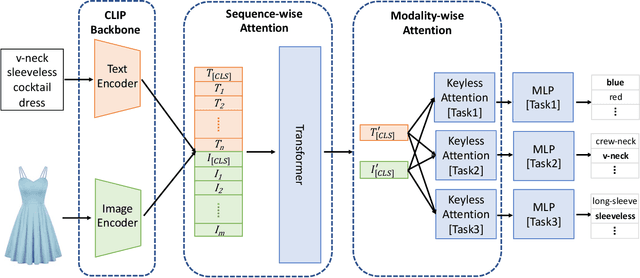
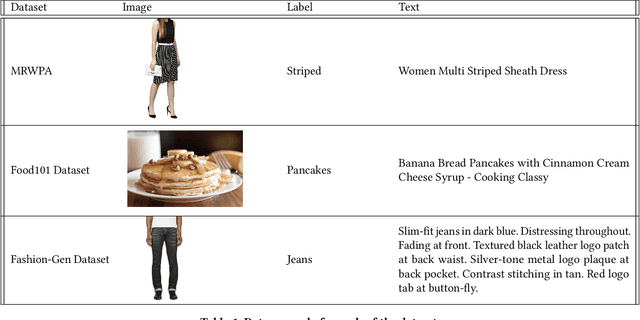

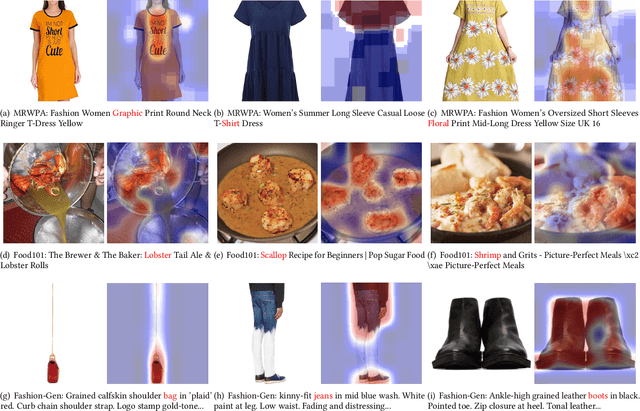
Abstract:Modern Web systems such as social media and e-commerce contain rich contents expressed in images and text. Leveraging information from multi-modalities can improve the performance of machine learning tasks such as classification and recommendation. In this paper, we propose the Cross-Modality Attention Contrastive Language-Image Pre-training (CMA-CLIP), a new framework which unifies two types of cross-modality attentions, sequence-wise attention and modality-wise attention, to effectively fuse information from image and text pairs. The sequence-wise attention enables the framework to capture the fine-grained relationship between image patches and text tokens, while the modality-wise attention weighs each modality by its relevance to the downstream tasks. In addition, by adding task specific modality-wise attentions and multilayer perceptrons, our proposed framework is capable of performing multi-task classification with multi-modalities. We conduct experiments on a Major Retail Website Product Attribute (MRWPA) dataset and two public datasets, Food101 and Fashion-Gen. The results show that CMA-CLIP outperforms the pre-trained and fine-tuned CLIP by an average of 11.9% in recall at the same level of precision on the MRWPA dataset for multi-task classification. It also surpasses the state-of-the-art method on Fashion-Gen Dataset by 5.5% in accuracy and achieves competitive performance on Food101 Dataset. Through detailed ablation studies, we further demonstrate the effectiveness of both cross-modality attention modules and our method's robustness against noise in image and text inputs, which is a common challenge in practice.
Training Federated GANs with Theoretical Guarantees: A Universal Aggregation Approach
Feb 09, 2021



Abstract:Recently, Generative Adversarial Networks (GANs) have demonstrated their potential in federated learning, i.e., learning a centralized model from data privately hosted by multiple sites. A federatedGAN jointly trains a centralized generator and multiple private discriminators hosted at different sites. A major theoretical challenge for the federated GAN is the heterogeneity of the local data distributions. Traditional approaches cannot guarantee to learn the target distribution, which isa mixture of the highly different local distributions. This paper tackles this theoretical challenge, and for the first time, provides a provably correct framework for federated GAN. We propose a new approach called Universal Aggregation, which simulates a centralized discriminator via carefully aggregating the mixture of all private discriminators. We prove that a generator trained with this simulated centralized discriminator can learn the desired target distribution. Through synthetic and real datasets, we show that our method can learn the mixture of largely different distributions where existing federated GAN methods fail.
Distribution Matching for Crowd Counting
Oct 25, 2020



Abstract:In crowd counting, each training image contains multiple people, where each person is annotated by a dot. Existing crowd counting methods need to use a Gaussian to smooth each annotated dot or to estimate the likelihood of every pixel given the annotated point. In this paper, we show that imposing Gaussians to annotations hurts generalization performance. Instead, we propose to use Distribution Matching for crowd COUNTing (DM-Count). In DM-Count, we use Optimal Transport (OT) to measure the similarity between the normalized predicted density map and the normalized ground truth density map. To stabilize OT computation, we include a Total Variation loss in our model. We show that the generalization error bound of DM-Count is tighter than that of the Gaussian smoothed methods. In terms of Mean Absolute Error, DM-Count outperforms the previous state-of-the-art methods by a large margin on two large-scale counting datasets, UCF-QNRF and NWPU, and achieves the state-of-the-art results on the ShanghaiTech and UCF-CC50 datasets. DM-Count reduced the error of the state-of-the-art published result by approximately 16%. Code is available at https://github.com/cvlab-stonybrook/DM-Count.
Latent Space Optimal Transport for Generative Models
Sep 16, 2018



Abstract:Variational Auto-Encoders enforce their learned intermediate latent-space data distribution to be a simple distribution, such as an isotropic Gaussian. However, this causes the posterior collapse problem and loses manifold structure which can be important for datasets such as facial images. A GAN can transform a simple distribution to a latent-space data distribution and thus preserve the manifold structure, but optimizing a GAN involves solving a Min-Max optimization problem, which is difficult and not well understood so far. Therefore, we propose a GAN-like method to transform a simple distribution to a data distribution in the latent space by solving only a minimization problem. This minimization problem comes from training a discriminator between a simple distribution and a latent-space data distribution. Then, we can explicitly formulate an Optimal Transport (OT) problem that computes the desired mapping between the two distributions. This means that we can transform a distribution without solving the difficult Min-Max optimization problem. Experimental results on an eight-Gaussian dataset show that the proposed OT can handle multi-cluster distributions. Results on the MNIST and the CelebA datasets validate the effectiveness of the proposed method.
Implementation of Stochastic Quasi-Newton's Method in PyTorch
May 07, 2018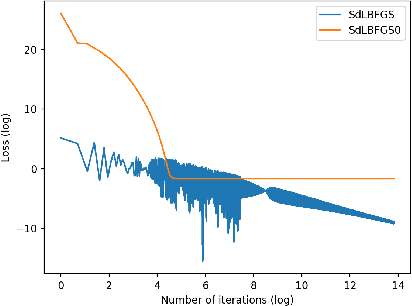
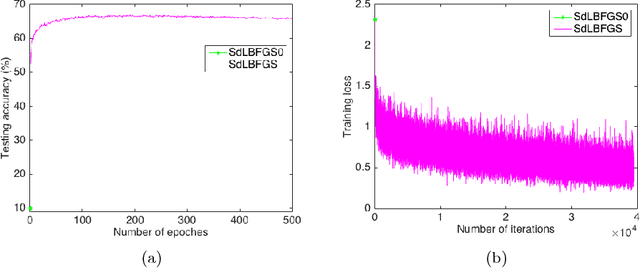
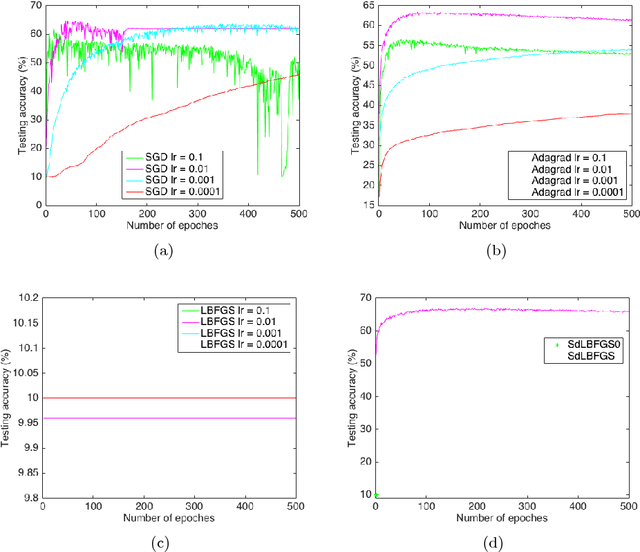
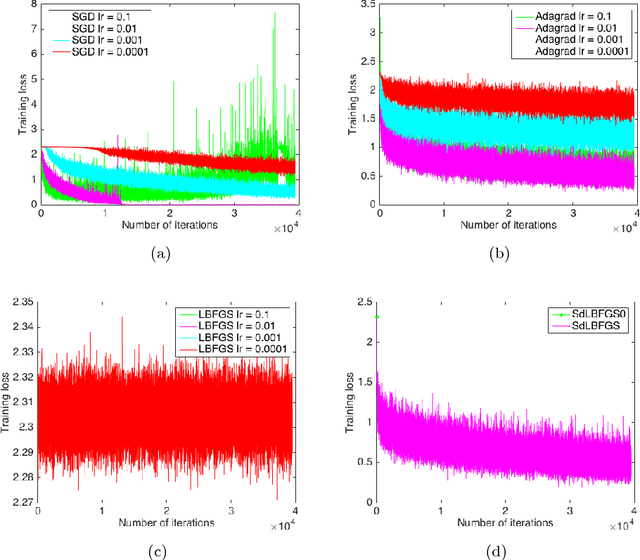
Abstract:In this paper, we implement the Stochastic Damped LBFGS (SdLBFGS) for stochastic non-convex optimization. We make two important modifications to the original SdLBFGS algorithm. First, by initializing the Hessian at each step using an identity matrix, the algorithm converges better than original algorithm. Second, by performing direction normalization we could gain stable optimization procedure without line search. Experiments on minimizing a 2D non-convex function shows that our improved algorithm converges better than original algorithm, and experiments on the CIFAR10 and MNIST datasets show that our improved algorithm works stably and gives comparable or even better testing accuracies than first order optimizers SGD, Adagrad, and second order optimizers LBFGS in PyTorch.
 Add to Chrome
Add to Chrome Add to Firefox
Add to Firefox Add to Edge
Add to Edge